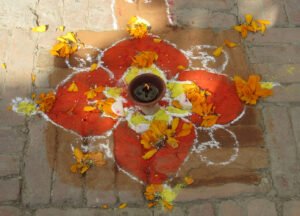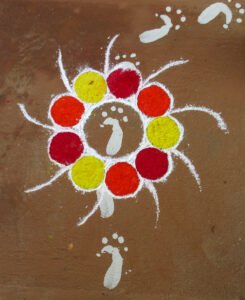Über 300 Fotos von Rangolis wurden dem Archiv CIRDIS, Universität Wien zu Dokumentations- und Forschungszwecken 2023 zur Verfügung gestellt.
Rangolis sind eine Form des Sandbildes und in Nepal eine sehr beliebte Kunstform. Es ist dies ephemere Kunst in seiner ursprünglichsten Form. Rangolis werden, besonders in den letzten Jahren vermehrt, als farbige Mandalas aus dem Handballen heraus angelegt. Dafür werden eingefärbte Pulver, meist fein gerieben aus Reismehl, zu Bildern und Mandalas gestreut. Die hier gezeigten Aufnahmen aus dem Jahr 2018 entstanden zum Fest des Lichts, Tihar, im Kathmandutal, Patan, im Stadteil Swotha und seinen angrenzenden Bezirken im nahen Radius.
Die Rangolis wurden jeden Morgen bis in den Vormittag hinein vor den Haustüren und Eingängen der Wohnhäuser ausgelegt, also unter freiem Himmel. Stets werden sie von einer weiblichen Person des Haushaltes ausgeführt, mit Vorliebe und nach Möglichkeit von der ältesten Tochter des Hauses. Diese Rangolis sollen die Göttin Lakshmi einladen, das Haus zu betreten und ihren Segen an die Bewohner auszuschütten. Lakshmi ist dafür bekannt, Reichtum, Gesundheit und Glück zu verschenken.
Die Mandalas werden mit großer Achtsamkeit und liebevoll gestreut, mit frischen Blumen geschmückt und mit kleinen Gaben wie Bananen, Äpfel, Orangenspalten versehen. Um die Göttin anzulocken, wird ein Öllämpchen im Zentrum des Rangolis entzündet, in einigen Fällen wurde die Richtung zum Eingang hin mit Fußspuren oder Pfeilen aus verdünntem roten Lehm (rato mato) verdeutlicht.
Am folgenden Tag wurden sie zusammengekehrt und ein anderes, frisches Rangoli nahm seinen Platz ein. Wiederum kunstvoll und voller Hingabe ausgeführt, jeden Tag im Verlauf des mehrtägigen Festes wiederholte sich die Prozedur.
Ich habe während meiner morgendlichen Rundgänge nur ein einziges Mal einen jungen Mann erlebt, der seiner frisch angetrauten Ehefrau bei dem Auslegen des Rangolis die Farben gereicht hat. Er saß neben ihr und verfolgte die Prozedur fasziniert. Es schien ausschließlich „Frauensache“ zu sein.
raṅgolī
Religious designs drawn by hand with some kind of powder, usually rice flour, are a common form of folk art throughout South Asia. In Nepal, in much of North India and the Deccan they are known as raṅgolī (< raṅgāvalī), in Tamil Nadu they are called kōlam, in Bengal alponā, or in Madhya Pradesh maṇḍana.
These symmetrical designs similar to a maṇḍala are usually placed at the front door of the house; therefore, they are also called threshold designs. This is done on certain special ritual occasions, in particular harvest or new year rituals in spring (Baisākhī) or autumn (Dīvālī). The underlying idea is generally that the designs protect the house from danger or bad influences and at the same time invite and welcome auspicious goddesses (Durgā, Pārvatī, Sarasvatī, Lakṣmī). The task of drawing the designs is almost exclusively carried out by women who take great pleasure in creating their own compositions.
The raṅgolī serving as the cover illustration for this felicitation volume is part of a collection of raṅgolīs documented by Linda Gaenszle in November 2018 during the festival of Tihāḍ (Dīpāvalī) in Swotha, a ward in the Newar city of Patan in the Kathmandu Valley. This is the Festival of Lights, and so at night every house or temple is adorned with rows of lamps – the traditional oil lamps in small clay bowls (diyo) or garlands of colorful electric bulbs. During the five-day celebration crows, dogs, cows and the Goddess of Wealth are worshipped and the bond between brothers and sisters is renewed. On every morning, new raṅgolīs are displayed in front of the entrances of the houses, i.e. on the street in open public space. The responsibility for the drawings is with the women of the house; preferably they are done by the eldest daughter of the household. The explicit purpose of the raṅgolīs is to invite the goddess Lakṣmī – who is at the center of the Tihāḍ festival. She is requested to enter the house and give her blessings to all its residents. Lakṣmī is known to provide wealth, health, and good luck. The designs are drawn in an act of devotion with colored flour or powder, and much care is taken that the auspicious raṅgolīs are well-formed and embellished with fresh flowers and small gifts of fruit, such as bananas and apples. In order to attract the goddess, a little oil lamp is often placed and lighted at the center of the raṅgolī. Occasionally foot prints or little arrows made of red color or clay (rāto māto) are added, showing Lakṣmī the way from the raṅgolī to the kitchen of the house. No chances are taken that she might get lost.
On the next day, the weathered raṅgolī is swept away, and a new, fresh one takes its place. Again, its creation is carried out artfully and with love and devotion. This procedure of creation and destruction, appearance and disappearance, life and death, is continued until the end of the festival. The art of raṅgolī is thus a truly ephemeral kind of art.
This collection of more than 250 fotos was made available to the Archive of CIRDIS at the the University of Vienna for documentation and further research by the artist.
Die hier vorgestellten Fotos sind ein Auszug aus der Sammlung, die ich dem Archiv CIRDIS, Universität Wien zu Dokumentations- und Forschungszwecken überlassen habe. Sie werden in Kürze abrufbar sein.


























